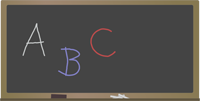-

Here are some suggestions for Multi-Sensory learning:
Reading Readiness
- Run your finger under the words as you read to your child to help her learn that words go from left to right and top to bottom. Locate front and back of book, “Picture Walk” where they explain the pictures to you. “Wh” questions as you read to them (who, what, where)
- Play games with rhyming words to help your child hear similar sounds in words. For example, as you are going up the stairs, name one word that rhymes with cat for each step as you go up.
- Read books or listen to stories online.
- Give your child two and three step directions. For example: "put on your pajamas, brush your teeth and pick a book to read."
- Play Simon Says with two or three step directions. For example: "Simon Says jump up and down and shout hooray."
Letter Recognition
- Play games to help your child recognize some letters of the alphabet.
- Play hide and seek with refrigerator magnets or flashcards or Go Fish
- Memory (flip two cards) is great way to practice any skill.
Beginning Sounds/Vocabulary
- Find items around the house that begin with the same sound and identify the letter that makes each sound.
- Vocabulary - label items in home, put items in categories (food, clothing, etc)
- Give clues of an object and let them guess what you are describing.
- Look through books, magazines, etc. find letters, sounds, words
Writing
- Help your child practice writing letters, especially the letters in her name.
- Write in shaving cream in the bathtub, salt or sugar in a cake pan or in finger paint to make practicing more fun and multisensory
- Dry erase boards, name puzzles, etc.
- “Magic Pencil” is a term we use (finger in the air)
Number Recognition and Counting
- Count throughout the day (for example, the crackers for snack or the socks in the laundry).
- Point out numbers you see in your environment and have your child name them (for example, the numbers found on food boxes or street signs).
- Put small objects in a bag, dump out, count and state or write “how many”
- Any board games – counting, matching, etc. Good for turn taking and social skill development also
Shapes and Colors
- Label the color and shape and sizes of objects around the house
- Help your child recognize more difficult shapes and draw them on paper then cut them out. Cutting is great fine motor practice.
- Tracing, drawing, coloring books etc. all good practice.
- Play games in which your child finds objects of particular colors and shapes around the house or in the neighborhood as you drive.
Fine/Gross Motor Skills & Sensory
- Give your child several different writing options (colored pencils, crayons or markers) to help keep her interested in writing and drawing.
- Playing with play dough is a fun way to strengthen the muscles of the hand that will be used for writing. Cutting play dough is also fun
- Use old magazines or newspapers to cut up, or make a collage of the things he likes, or practice letter and number skills.
- Scissor skills - snip paper, draw a line and they cut etc.
- Lacing and shoe tying
- String beads, cereal, elbow pasta
- Squeeze a spray bottle - water plants, "erase" chalk game
- Magic sand, dried beans, rice – add small objects and have students use tongs to retrieve and describe.
- Lego, building blocks
- Painting, chalk, bubbles
- Q-tip painting
- Balloon tennis, volleyball or catch
- Play catch or kick ball back and forth
- Make a simple obstacle course where you can run, jump, crawl...
- Use dried pasta or rice to "dig in"
- Write in shave cream
Select a School...
Select a School
- 79th Street Elementary
- Harry F. Abate Elementary
- Cataract Elementary
- Hyde Park Elementary
- Henry J. Kalfas Elementary
- Geraldine J. Mann Elementary
- Maple Avenue Elementary
- Bloneva Bond Primary School
- Gaskill Preparatory
- LaSalle Preparatory
- Niagara Falls High School
- Community Education Center
- COVID-19 Crisis Management

